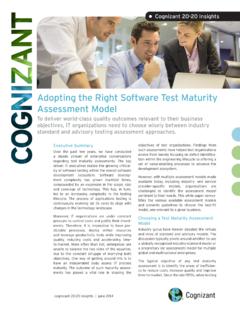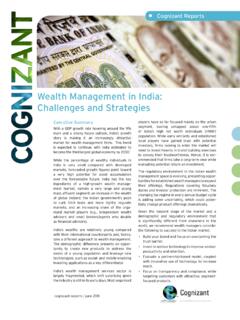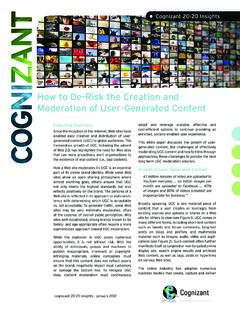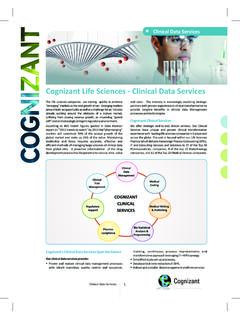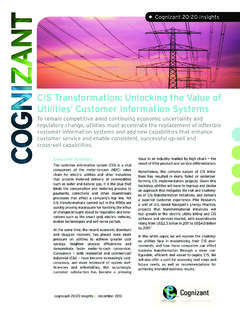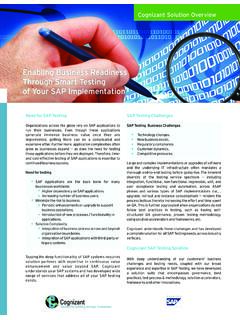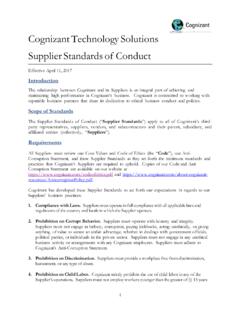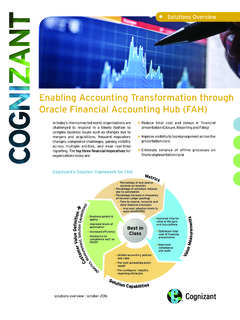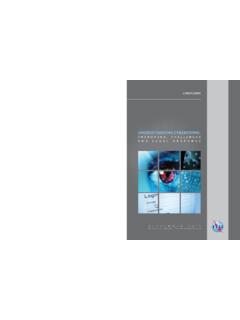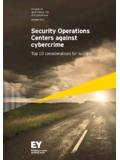Transcription of Financial Crime: How Financial Institutions Can Mitigate ...
1 Cognizant Reportscognizant reports | may 2016 Financial crime : How Financial Institutions Can Mitigate Risk and Improve Compliance Banks face dramatically higher operating costs and business complexity, with the increased scope of Financial crimes and growing regulatory liabilities, highlighting the need for a more integrated and unified approach to risk mitigation and compliance. cognizant reports2 Executive SummaryTop Financial industry executives are increas-ingly concerned about the rising sophistication of Financial crimes, including money laundering, terrorism financing, cybercrime, fraud, tax eva-sion, bribery and internal threats from employ-ees.
2 At the same time, the number of banks being penalized for regulatory and sanctions violations in the , the UK, the European Union and else-where has spiked in recent years, demanding greater transparency, responsibility and compli-ance. Furthermore, the increase in extra-territo-rial enforcement of laws and reciprocation from other countries has amplified compliance challenges, vastly increasing the cost and com-plexity of doing business. Banks have made huge investments in risk and compliance management, but their fragmented approach to Financial crime has had limited success in staving off threats and meeting regula-tory requirements.
3 This has resulted in increased violations and money spent on regulatory , banks need to refresh their approach to handling Financial crime and regulatory compli-ance. We recommend six key steps to help banks adapt to the ever-changing criminal and regula-tory landscape. Conduct a risk assessment based on the bank s products, services, geographies and clients to better understand the threat envi-ronment. Integrate the efforts of various disciplines involved in Financial crime prevention across the organization to identify synergies and overlaps in people, processes and technolo-gies; this will help reduce redundancies and streamline processes.
4 Improve the availability and quality of data to support real-time transaction monitoring and advanced analytics. Apply advanced analytics to gain a holistic view of threats and the entities that cause them; this will help uncover complex and sub-tle threats, as well as emerging ones, early and effectively. Nurture a culture of high ethics and integrity by setting accountability standards, establish-ing controls and policies, working closely with regulators and increasing employee awareness. Actively participate in the industry-wide initiatives undertaken to Mitigate risk and improve Growing Burden of Financial crime and Regulatory Compliance Criminals are more sophisticated than ever when it comes to Financial and cybercrime, and banks are struggling to catch up.
5 Meanwhile, increased regulatory demands for transparency and compli-ance, as well as hefty penalties for non-compli-ance, have put enormous pressure on banks, both financially and operationally. Rising Threats A number of drivers including globalization, the proliferation of banking channels, rising transaction volumes and accelerated technol-ogy advancements ( , new digital tools and intelligent automation) have introduced new 42%15%11%10%10%10%Evolving criminal methodologiesCost of AML complianceLack of personnel in risk functionCivil prosecution/class actionsGeo-political eventsSectoral sanctionsSingle Biggest Barrier to Fighting Financial crime Effectively for UK Banks Figure 1 Source.
6 The British Bankers Association and LexisNexis, November 2015 Base: 198 senior-level Financial crime and AML compliance professionalscognizant reports3opportunities for Financial malfeasance. Crimi-nals continuously probe banking organizations defenses through innovative algorithms and complex schemes across channels and vectors; banks must also guard against internal employee threats (see Figure 1, previous page). Big banks are not the only targets; small banks are easy prey for criminals, as many lack robust systems to fend off Regulatory Scrutiny and Surging Compliance CostsRegulators across the globe have intensified their scrutiny and are assessing heavy fines to banks that fail to adopt adequate defenses or that violate the Banking Secrecy Act/Anti-Money Laundering (BSA/AML) program.
7 Between 2007 and 2014, banks paid about $21 billion in cumula-tive anti-money laundering (AML) fines alone in the Banks are continuously challenged by emerging AML compliance requirements (see Figure 2). This includes the long-awaited beneficial owner-ship rule from the Financial Crimes Enforcement Network (FinCEN), expected to be finalized this year, which will require banks to verify and iden-tify the true owner of companies behind Financial transactions. Banks will also need to understand the implications of the ongoing assessment of the Anti-Money Laundering/Combating the Financing of Terrorism (AML/CFT) framework developed by the Financial Action Task Force (FAFT).
8 In response to the 2001 terrorist attacks, the significantly expanded the scope of laws govern-ing money laundering, bribery and fraud and applied them extra-territorially; the European Union and the UK followed suit. The EU s Anti-Money Laundering Directive (AMLD 4) which will be implemented by member states starting June 26, 2017 requires Financial Institutions to continuously identify, evaluate and document risks related to money laundering and terrorist financing; report suspicious transactions made by their clients; and maintain records of payments.
9 Sanctions compliance is another major challenge for global banks as they strive to keep pace with a dynamic sanctions list comprising individu-als, countries and Institutions , separately main-tained by the EU, the and organizations such as the United Nations. Banks must also keep up with lists for AML, tax evasion and other forms of crime . The growing list of individuals and enti-ties to be screened has put pressure on banks transaction screening systems, increasing the number of false positives generated. authori-ties have clamped down on foreign banks for lax controls over Financial crime and sanctions; Euro-pean banks are most affected by this crackdown (see Figure 3, next page).
10 In the UK, the Financial Conduct Authority (FCA) has increased its scrutiny and updated its guid-ance on Financial crime prevention. The move was based on a 2014 review of 21 small banks, which found significant weaknesses in the AML systems and controls in high-risk situations at most banks; AML Compliance Challenges in the Next 12 MonthsFigure 2 Source: Dow Jones and ACAMS, 2016 Base: 812 AML, BSA and/or compliance executives58%40%37%36%25%20%18%16%11%10% 8%Increased regulatory expectations and enforcementHaving enough properly trained AML staffAdditional regulationsInsufficient/outdated technologyToo many false positive screening resultsSanctions complianceUnderstanding regulations outside home countryFormal regulatory criticismFear of personal civil and criminal activityLack of senior management/board engagementUnderstanding regulations in home countrycognizant reports4additionally.
